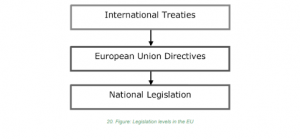Lesson 3: Design for compliance with regulations and standards
In this lesson, we’ll explore the critical role of compliance with regulations and standards in eco-product design. Ensuring that products meet environmental and safety requirements is essential for sustainability and legal compliance.
- EU REGULATION
The EU has a comprehensive framework of regulations related to eco-design and environmental protection.
Key Areas Covered by EU Regulation:
- Solid Waste Management (SWM)
- Energy Using Products (EuP) and Energy Related Products (ErP)
- Industrial Machines
- Restrictions on Hazardous Substances (RoHS)
- Telecommunications and Radio Equipment
- Product Safety
- INTERNATIONAL STANDARDIZATION ORGANIZATIONS
International standards are crucial for ensuring consistency and quality in eco-product design.
Prominent International Standardization Organizations:
- ISO (International Standardization Organization)
- IEC (International Electrotechnical Commission)
- ITU (International Telecommunications Union)
- REGIONAL STANDARDIZATION ORGANIZATIONS
Regional standards organizations play a significant role in standardizing products for specific geographical regions.
Examples of Regional Standardization Organizations:
- CEN (European Committee for Standardization)
- CENELEC (European Standardization Committee in Electrotechnics)
- ETSI (European Institute for Electro-Technical Standardization)
- COPANT (Pan-American Standardization Commission)
- MERCOSUR (South Common Market)
- NATIONAL STANDARDIZATION ORGANIZATIONS
Each country has its own national standardization system and organizations.
Examples of National Standardization Organizations:
- AUSTRIA: Austrian Standards Institute – ON
- UNITED KINGDOM: British Standard Institution – BSI
- GREECE: Hellenic Organization for Standardization – ELOT
- ROMANIA: Romanian Standard Institution – ASRO
- SERBIA: Institute for Standardization – SRPS
- ISO 14000 SERIES STANDARDS
ISO 14000 series standards are pivotal in environmental management.
Areas Covered by ISO 14000 Standards:
- Environmental Management System
- Environmental Audit
- Environmental Evaluation of Performance
- Environmental Labelling
- Evaluation of the Life Cycle of Products
- Evaluation of Environmental Aspects in Production Standards
System and Product Oriented Standards:
- ISO 14001: Environmental Management System
- ISO 14004: Environmental Management System Guidelines
- ISO 14010, 14011, 14012, 14015: Environmental Auditing
- ISO/TR 14061: Informative Reference Material for Forestry Organizations
- ISO 14031, TR 14032: Environmental Performance Evaluation
- ISO 9000: Quality Management Systems
- ISO 19011: Guidelines for Quality and Environmental Management Systems Auditing
- ISO 14020, 14021, 14024, TR 14025: Environmental Labelling
- ISO 14040, 14041, 14042, 14043, 14044, TR 14049, TR 14048, ТР 14047: Life Cycle Assessment
- ISO GUIDE 64: Guide for Inclusion of Environmental Aspects in Product Standards
- ISO TR 14062: Integrating Environmental Aspects Into Product Design and Development
- ISO DIS 14063: Environmental Communication
- ISO DIS 14064: Greenhouse Gases
ECO-MANAGEMENT AND AUDIT SCHEME (EMAS)
EMAS is a program within the EU that guides companies toward environmentally responsible product development.
EMAS Key Areas:
- Compliance with new environmental laws and regulations
- Company strategy for new markets
- Adoption of new technologies in manufacturing or packaging
- Changing customer expectations and lifestyles
Approaches to Measure Environmental Performance:
- Input measures
- Emissions/waste measures
- Resource measures
- Efficiency measures
- Customer measures
- Financial measures
- Risk measures

Conclusion:
- Compliance with regulations and standards is essential for eco-product design to ensure environmental protection, safety, and sustainability.
- International, regional, and national standards organizations play a pivotal role in setting the guidelines for eco-product design.
- ISO 14000 series standards provide a comprehensive framework for environmental management.
- EMAS helps companies integrate environmental considerations into product development.